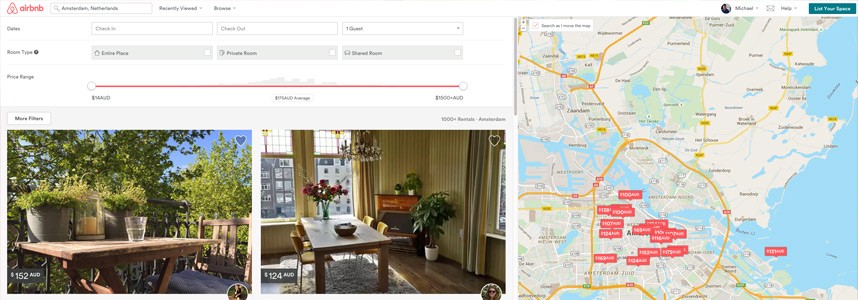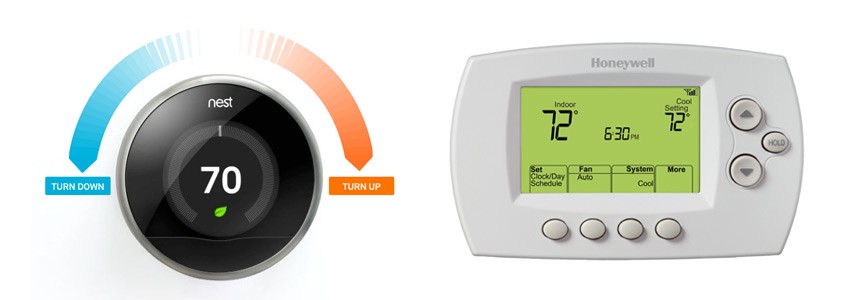4 invisible UXs you never knew about
- Transfer
Great design is invisible

Airbnb, Disney World, Uber and Nest. These are all phenomenal products whose total value exceeds $ 135 billion. But not only their services have achieved excellent performance, their user interactions are so well thought out and implemented that their strategy is unnoticed. In other words, the “user experience” has remained in the background.
A good designer can organize chaos. An experienced designer can eliminate this chaos.
When designing user interactions with a product, the most common question I ask myself is: “ What are the least actions a user must take to achieve the desired result? ”
Who will enjoy the fuss with drop-down lists, input fields or buttons? Sometimes, as designers, we can be distracted by the extra noise, thinking through user interaction. We focus on " beautifully designed forms " because they are easier to use. I found this method effective enough to think about the ultimate goal and work in the opposite direction. This will allow you to pay attention not only to the user interface, but also really concentrate on important things.
“Design is only apparent in retrospect”
As designers, it is important for us to more holistically represent both the product itself and the interaction with it. Pixel polishing is certainly necessary, but user interaction is so important that an unnoticed design is even better.
Netflix founder Jared Spool explains how Netflix sends out a poll to its users asking them to note what they like most about the service. Clients reply: “A wide selection of films, a recommendation tool that helps to make the service better overall” However, no one mentions the fast functionality of the site, the intuitive and well-implemented interface.
Jared Spool:
“At that time, all these things, carefully worked out by Netflix designers, went unnoticed by customers ... This is not because they are not important. This is because the designers really did their job well - they kept all these moments in the shade. ”
1. Airbnb - Design is more than great pixels

When booking a seat on Airbnb, the price that the owner wishes to receive when placing guests who contacted him is indicated. In retrospect, Airbnb may have hundreds of “free” places to sleep, but if the landlord does not provide such places, you can only have negative experience.
So what does Airbnb do to quickly provide you with real value?
Everything happens behind the scenes. Airbnb search is fairly simple, and the forms are very minimal. When you make an inquiry to Airbnb, the latter uses machine learning to determine their preferred housing.
Without going into details about how it works, Airbnb created a machine learning model that studies the behavior of the owners and their housing requests. With this understanding, the company can optimize the requests of the "guests" with the results of the search for housing, the owners of which will accept your request as a priority. This makes the Airbnb user experience more meaningful, because most likely you will receive a quick and successful response from the owner of the rental property.
I have not yet met a host who would not answer.
2. Disney World - a magical experience of interaction, without market costs.

Disney World has invested $ 1 billion in a program called MyMagic + . Why? Because this allows the company to avoid the additional costs associated with the purchase of tickets, booking tables in restaurants, places for shows and attractions. This magical interaction experience is realized through an invisible design.
It all starts with booking your places to visit. Behind the scenes, the company "captures" us, using our interests. Using this data, Disney World splits your preferences and then builds a journey through the park - the bracelet tries to "guide" the user along a path that seems optimal for the system.
This invisible experience also flows into the restaurant reservation mechanism. When you book a table, the owner of the restaurant already knows your name. In fact, you can sit anywhere and your food will magically find its way to you! How? The restaurant is equipped with modern sensors that open up a whole world of new opportunities for their owners.
Disney World , knowing your location in their magical park, also opens up many opportunities for delivering an increasingly magnificent user experience. Just imagine that your favorite children's characters themselves will come to you, instead of wading through a line of people who also want to play with them.
As you may have noticed, great design brings a huge user experience.
From a business point of view, the company is able to optimize each route of people seeking to better explore the main attractions of the park. When visitors spend less time in lines, they can do more, and ultimately spend more!
3. Uber — Destroying an entire industry on one screen

Taxi on demand.
Has anyone thought that you can blow up an entire industry on one screen?
Before Uber, taxi use turned into a nightmare. Being stuck in traffic at 4 a.m. in the winter in Sydney is not the best pastime.
- You do not know when the taxi will be free.
- You do not know where the taxi awaits you.
- You do not know the exact fare to the desired location.
Uber user experience design is phenomenal. In terms of interaction, Uber solves all client uncertainties on one screen.
In an open application ( with location mode enabled ), the user does not need to interact with any interface elements to find out the exact fare. In my opinion, this is a great example of the one-page design industry. They stuck on their foreheads: “What are the least actions a user must take to achieve the desired result?” The
application allows you to:
- Keep track of where taxis are now available.
- Calculate the time of arrival ordered by taxi.
- Call Uber user experience ( only at first glance ) trivial and retrospective. Remembering the previous experience of " ordering a taxi "; the most obvious “solution” seems to have been a phone call leaving his name to the dispatcher and indicating his blurry location.
If you have noticed, with the success of Uber, the whole concept of booking a taxi has decreased. Uber does not allow " order a taxi for tomorrow "; he destroyed and turned over all the standards and expectations of the industry.
4. Nest - a self-learning thermostat

Today's thermostats are expensive, complex, and inefficient. Tony Fadell saw this as a major problem, so he created Nest. As a designer of 18 generations of iPods and 3 generations of iPhones , he used his skills to create a smart thermostat .
Most people do not program their thermostats because of many reasons - for me this is due to the fact that they are very uncomfortable. The Nest team has realized how experienced user interaction is that it is literally hidden.
In the first week after installation, the thermostat will study your preferences and personalized schedule. Here are some of the features that it includes:
- The ability to track your location using location settings and turning on the power when you are far away.
- Based on the previous paragraph, the device allows you to warm or cool the room before you return home.
- Nest remembers your habits at night and turns off the power.
- Signals tell you to save energy.
- Nest’s valuable suggestion is that you train their device for your habits, which later helps you save money.
This is great because everything happens behind the scenes. The only thing required of the user is to monitor the temperature during the first week. No need to bother with unnecessary user interface elements. No wonder why Nest was acquired by Google .
The surge in personal assistant applications
Gorgeous ( invisible ) design comes at a great price.
As we endure technological advances, we are improving our understanding of these technologies, data, user behavior and their expectations, and all user experiences are becoming more and more real. That is why there has been a surge and increase in demand for personal assistant applications.
What brings Portal, Emu, VidaHealth, Mindy, Cortana, Siri, and Google together?
They are all stepping stones to experienced user experience. All are aimed at achieving this kind of interaction when “data processing” takes place behind the scenes. “In the face of the consumer, why do I need to click on the form to say what I need? Is it because we are still using the old methods, or is this interaction really better overall? ”
I believe that some of these personal assistants are still largely dependent on manual user settings, but as these startups continue to capture more and more information, the ability to automate many manual work will soon become available. In the next 5 years, we will see technologies that become even more integrated than ever, and interaction with them will become even easier. I am absolutely shocked at what the Microsoft Cortana team is doing!
Conclusion
I hope that you learned something interesting from this article and that you can put these design principles into practice. I urge you to plunge into the study of new ways to interact with digital products. We live in a digital age where many things are possible. Leave the comfort zone of trendy patterns and trends - they are not eternal.
“A man has done all these things, and he can improve them. Do not be afraid. Go to the action. "- Tony Fadell
